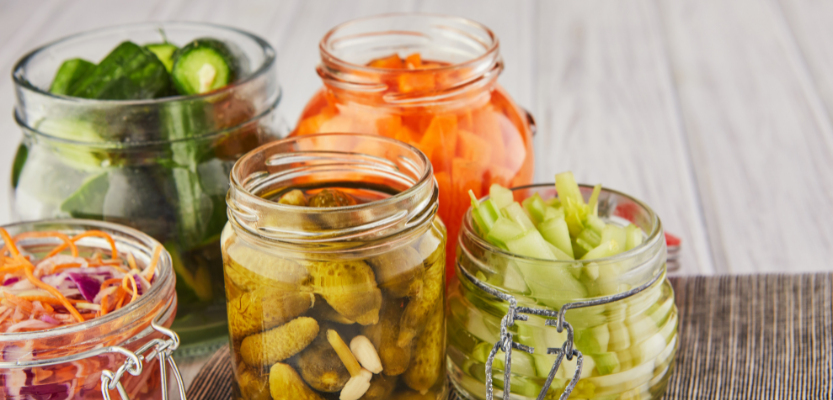In recent years, fermented foods have made a significant comeback in the wellness world, and for good reason. These nutrient-rich foods not only add unique flavors to your meals but also offer a wealth of health benefits that can transform your overall well-being. From supporting digestion to boosting immunity, fermented foods are a powerful addition to any diet.
But what exactly are fermented foods, and how can you easily incorporate them into your daily routine? In this blog, we’ll explore the science behind fermented foods, their incredible health benefits, and share seven simple recipes you can make at home to start enjoying the benefits today.
What Are Fermented Foods?
Fermentation is a natural process in which microorganisms like bacteria, yeast, or fungi break down carbohydrates (such as sugars and starches) into organic acids, gases, or alcohol. This process not only preserves the food but also enhances its nutritional value by creating beneficial enzymes, B vitamins, omega-3 fatty acids, and probiotics.
Fermented foods have been a staple in many traditional diets for centuries, from sauerkraut in Germany to kimchi in Korea and kefir in the Caucasus. These foods have stood the test of time not only because of their distinctive flavors but also because of their remarkable health benefits.
The Health Benefits of Fermented Foods
Fermented foods are more than just tasty additions to your meals—they’re also packed with health benefits that can help you thrive. Here are some of the top reasons to include fermented foods in your diet:
1. Improved Digestion
One of the most well-known benefits of fermented foods is their ability to support digestion. The probiotics created during fermentation help balance the gut microbiome, promoting a healthy digestive system. This can lead to better nutrient absorption, reduced bloating, and relief from digestive issues like irritable bowel syndrome (IBS).
2. Boosted Immune System
A significant portion of your immune system is located in your gut, so maintaining a healthy gut microbiome is crucial for overall immunity. The probiotics in fermented foods can enhance immune function by stimulating the production of antibodies and strengthening the gut barrier, making it more difficult for harmful pathogens to enter your bloodstream.
3. Enhanced Nutrient Absorption
Fermentation increases the bioavailability of nutrients in food, making it easier for your body to absorb essential vitamins and minerals. For example, fermented vegetables have higher levels of vitamin C and B vitamins, while fermented dairy products like yogurt and kefir are rich in calcium and vitamin K2.
4. Reduced Inflammation
Chronic inflammation is linked to a variety of health issues, including heart disease, diabetes, and autoimmune conditions. The probiotics in fermented foods have anti-inflammatory properties that can help reduce inflammation in the body and promote overall health.
5. Improved Mental Health
The gut-brain axis is a powerful connection between the digestive system and the brain. By supporting gut health with fermented foods, you can also positively impact your mental health. Studies have shown that probiotics can help reduce symptoms of anxiety and depression, improve mood, and enhance cognitive function.
6. Weight Management
Fermented foods can support healthy weight management by improving digestion and helping to regulate appetite. The probiotics in these foods can also influence the hormones that control hunger, such as ghrelin and leptin, making it easier to maintain a healthy weight.
7. Heart Health
Some fermented foods, such as kimchi and miso, contain compounds that can help lower blood pressure and reduce cholesterol levels, promoting heart health. The probiotics in fermented foods can also support heart health by reducing inflammation and improving blood lipid profiles.
7 Easy Fermented Food Recipes to Try at Home
Now that you know the benefits of fermented foods, let’s dive into some easy recipes you can make at home. These recipes require minimal ingredients and equipment, making them perfect for beginners.
1. Homemade Sauerkraut
Sauerkraut is a classic fermented cabbage dish that’s rich in probiotics and has a tangy, crunchy texture.
Ingredients:
- 1 medium head of cabbage
- 1 tablespoon sea salt
Instructions:
- Remove the outer leaves of the cabbage and slice it thinly.
- Place the cabbage in a large bowl and sprinkle with salt.
- Massage the cabbage with your hands for about 10 minutes until it releases its juices.
- Pack the cabbage tightly into a clean glass jar, pressing down to submerge it in its own juices.
- Cover the jar with a cloth or lid and let it ferment at room temperature for 1-4 weeks. Taste periodically until it reaches your desired level of tanginess.
2. Kimchi
Kimchi is a spicy Korean fermented vegetable dish that’s packed with flavor and beneficial bacteria.
Ingredients:
- 1 medium head of Napa cabbage
- 1 tablespoon sea salt
- 1 tablespoon grated ginger
- 3 cloves garlic, minced
- 1 tablespoon Korean red pepper flakes (Gochugaru)
- 1 tablespoon fish sauce (optional)
- 2 green onions, chopped
- 1 medium carrot, julienned
- 1 daikon radish, julienned
Instructions:
- Slice the cabbage and sprinkle with salt. Let it sit for 1-2 hours to release moisture.
- Rinse the cabbage and drain well.
- Mix the ginger, garlic, red pepper flakes, fish sauce, green onions, carrot, and radish in a bowl.
- Add the cabbage to the mixture and toss to coat evenly.
- Pack the kimchi into a glass jar, pressing down to remove air bubbles.
- Cover the jar and let it ferment at room temperature for 3-7 days, then refrigerate.
3. Kombucha
Kombucha is a fermented tea drink that’s refreshing, slightly tangy, and full of probiotics.
Ingredients:
- 4 cups water
- 4 black or green tea bags
- 1 cup sugar
- 1 SCOBY (Symbiotic Culture of Bacteria and Yeast)
- 4 cups filtered water
Instructions:
- Boil 4 cups of water and steep the tea bags for 10 minutes.
- Remove the tea bags and stir in the sugar until dissolved.
- Let the tea cool to room temperature, then transfer to a large glass jar.
- Add the SCOBY and 4 cups of filtered water to the jar.
- Cover the jar with a cloth and let it ferment at room temperature for 7-10 days.
- Taste the kombucha; when it reaches your preferred flavor, remove the SCOBY and transfer the kombucha to bottles. Refrigerate.
4. Pickled Vegetables
Pickled vegetables are a versatile and easy way to enjoy fermented foods with a variety of flavors.
Ingredients:
- 4 cups mixed vegetables (e.g., carrots, cucumbers, radishes)
- 2 cups water
- 2 cups vinegar
- 2 tablespoons sea salt
- 2 cloves garlic, minced
- 1 teaspoon mustard seeds
- 1 teaspoon black peppercorns
Instructions:
- Slice the vegetables and pack them into glass jars.
- In a saucepan, heat the water, vinegar, salt, garlic, mustard seeds, and peppercorns until the salt dissolves.
- Pour the brine over the vegetables, making sure they are fully submerged.
- Cover the jars and let them ferment at room temperature for 3-7 days, then refrigerate.
5. Yogurt
Homemade yogurt is creamy, tangy, and full of beneficial probiotics.
Ingredients:
- 4 cups milk (dairy or non-dairy)
- 2 tablespoons yogurt starter or plain yogurt with live cultures
Instructions:
- Heat the milk to 180°F, then cool to 110°F.
- Stir in the yogurt starter or plain yogurt.
- Pour the mixture into a glass jar and cover.
- Keep the jar in a warm place (around 110°F) for 6-12 hours until the yogurt sets.
- Refrigerate before serving.
6. Miso Paste
Miso is a Japanese fermented soybean paste that adds umami flavor to soups, marinades, and dressings.
Ingredients:
- 2 cups cooked soybeans
- 1/2 cup miso starter (koji)
- 1 tablespoon sea salt
Instructions:
- Mash the cooked soybeans until smooth.
- Mix in the miso starter and salt.
- Pack the mixture into a glass jar, pressing down to remove air pockets.
- Cover the jar and let it ferment at room temperature for 6 months to 1 year.
7. Fermented Salsa
Fermented salsa is a tangy, probiotic-rich version of the classic dip.
Ingredients:
- 4 ripe tomatoes, diced
- 1 onion, diced
- 2 cloves garlic, minced
- 1 jalapeño pepper, chopped
- 1/4 cup cilantro, chopped
- 1 teaspoon sea salt
- Juice of 1 lime
Instructions:
- Combine all the ingredients in a bowl and mix well.
- Transfer the mixture to a glass jar, pressing down to remove air bubbles.
- Cover the jar and let it ferment at room temperature for 2-3 days, then refrigerate.
Embrace the Power of Fermented Foods
Incorporating fermented foods into your diet is a delicious and effective way to boost your health. From improved digestion to enhanced immunity, the benefits of these probiotic-rich foods are truly transformative. Plus, making your own fermented foods at home is easier than you might think, and it allows you to enjoy fresh, flavorful additions to your meals.
If you’re ready to explore how fermented foods can support your health and well-being, I invite you to book a complimentary 15-minute discovery call today. You may also reach out via (416) 551-9577 or email admin@thedempsterclinic.com.
Together, we can create a personalized plan that includes the right fermented foods and other strategies to help you achieve optimal health.

